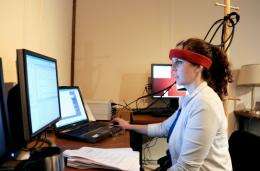May 16, 2012 report
Brainput system takes some brain strain off multi-taskers

(Phys.org) -- A research team made up of members from Indiana University, Tufts and MIT and led by Erin Treacy Solovey, a has built a brain monitoring system that offloads some of the computer related activities a person is performing when multi-tasking begins causing stress. Called Brainput, the system makes use of functional near-infrared spectroscopy (fNIRS) to monitor brain activity and a computer system to interpret the results and then to cause changes to tasks to reduce brain overload, i.e. when stress levels reach a certain point, the computer turns on autonomous computer activities that hopefully reduce the amount of stress the person is experiencing.
In practice, the fNIRS system is made up of a headset worn across the forehead that is able to capture electrical signals from the brain, combining features of fMRI and EEG in one small, less powerful package. The headset is connected to a computer running software that analyses the signals it receives and then when certain patterns emerge, takes actions that lesson the load on the person wearing the headset.
To test their system, the researchers set up an experiment where volunteers were asked to direct virtual robots in a maze with the goal of finding a spot where a Wi-Fi signal was powerful enough to allow for sending messages. To up the stress factor, the volunteers were asked to direct two robots at the same time, which was doubly difficult because both robots continued to move regardless of commands given and because the volunteers were also asked to do their best to prevent the robots from running into walls. The setup thus required the volunteers to multi-task in a stressful environment. As the experiments unfolded, the Brainput system constantly monitored the brain activity of each participant and when certain thresholds were reached, commands were sent to the robots turning on their sensors and directing them to perform some actions autonomously; in essence, helping out the volunteers. What’s perhaps most interesting about the experiments is that most of the volunteers never even noticed that the robots had started helping them out. For their part, the researchers noted that performance levels overall increased when the robots started doing their fair share. Also interesting was when autonomous behavior by the robots was instigated prior to the volunteers reaching overload, they tended to notice what was going on and performance dropped off as a result.
Solovey and her team plan to next add other cognitive recognition algorithms to the system to detect other mental states allowing for assistance in wider variety of applications. Possible real-world uses for such a system might include driver or pilot assist applications that help out when the person in control temporality loses focus or becomes fatigued.
More information:
web.mit.edu/erinsol/www/fNIRS.html
Research paper (PDF): web.mit.edu/erinsol/www/papers … y.CHI.2012.Final.pdf
via TechnologyReview
© 2012 Phys.Org



















